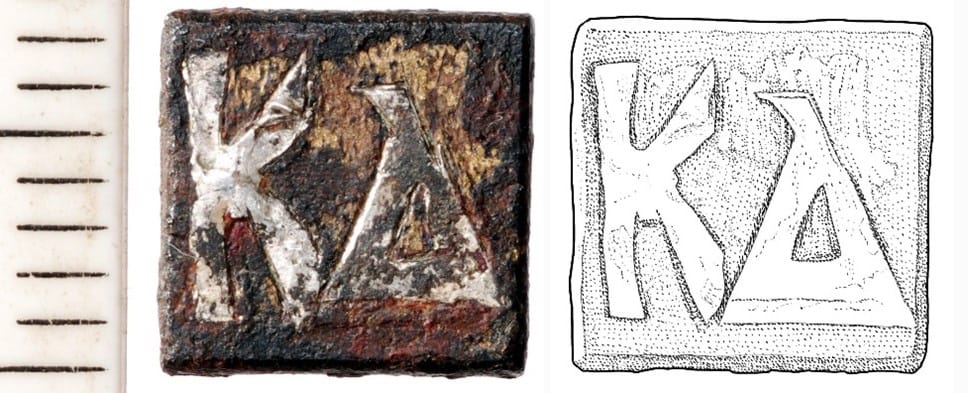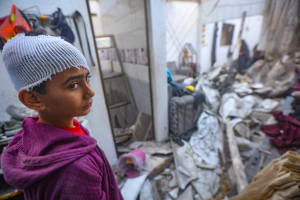Rare discovery leads scholars to claim a church was built on Temple Mount during Byzantine period
Two rare Byzantine-Christian weights discovered from Temple Mount sifting project

Two rare weights dated to the Byzantine era were recently discovered at the sifting project of the Temple Mount debris.
The latest discovery was published in the last Israel Numismatic Research Journal (INS), authored by the project's directors Gabriel Barkay and Zachi Devira, and Haim Shaham, an archaeology doctoral student at the Bar-Ilan University.
The archaeologists announced that the two finds belong to a series of previous discoveries from the sifting project that were all dated to the same periods and are related to monumental buildings and Byzantine churches.
The weights, dated to the 6th century A.D., together with these other items discovered in the sifting project, are evidence of a Christian presence on the Temple Mount before the Muslim conquest of Jerusalem. These archaeologists believe that a church may have once stood there, contrary to what scholars believed till now.
The Temple Mount, revered as the most sacred site in the Jewish faith, served as the setting for both the initial and subsequent biblical temples. Situated in Jerusalem's Old City, this contentious locale is recognized as Islam's third holiest site, following Mecca and Medina. It encompasses the Dome of the Rock and the Al-Aqsa Mosque. The historical significance of an early Christian presence on the Temple Mount, apart from a later Crusader presence, has not garnered significant attention from historians and has been marginalized by authorities and the academy.
The sifting project began in 2004 in an attempt to save the tons of dirt and debris forcefully extracted by heavy trucks from the Mount area and thrown away out from the walls of the Old City. The illegal act, which was conducted by the Muslim Waqf - a religious organization that managed the maintenance of the Temple Mount - provoked anger among Israelis, who claim that the Waqf prioritized Islamic interests under the noses of Israeli authorities and the Israel Antiquities Authority (IAA).

Critics later emerged, holding the government responsible for allowing the Waqf to damage the World Heritage site - damage that was irreversible. Since then, and at the request of Jewish organizations, the sifting project came into being.
This particular archaeological project is unusual as it mainly involves sifting debris that hasn't been scientifically excavated from its original context. Even if the project workers are able to identify some layer sequences, it is often a mix of items across many time periods items together.
Today it is clear to many archaeologists and scholars, who are familiar with this project, that the areas where the debris is coming from were mostly major filling areas for construction waste and rubble from destruction debris over different periods.
Weighing a mere 0.6 grams each, the petite weights are unique in that one was crafted from brass and the other from glass. They are believed to be official imperial weights and according to an analysis, they most likely served as required components in major churches, in accordance with 6th-century Byzantine law. According to the archaeologists, the exceptional rarity of these artifacts stems from their precise weight and diminutive size.
The weight is made of brass alloy and has a thin covering of silver with Greek letters: “Kappa,” “Delta” and is believed to have been produced during the 5th and 6th centuries A.D. The item is square, measuring 13mm on each side and is 1.6 mm thick. The archaeologists believe it is equivalent to four carats.

The glass weight, believed to have been produced and distributed from Constantinople (modern-day Istanbul) during the years 550 – 650 A.D. is about 17 mm and 2 mm thick. The weight has an impression of a “haloed Imperial bust above a cross-shaped monogram flanked by two smaller busts.” In addition, there is a monogram with an inscription: “Of Euthalios” or “belonging to Euthalios.” The archaeologists believe the name is likely displaying where the weight was manufactured and produced.
Since 2004, the archaeologists at the sifting project have discovered other major finds that are related to ancient Byzantine churches, such as beautiful Byzantine floor tiling, and Tesserae (small mosaic square stones) chancel screens, and are thought to be related to monumental Byzantine buildings.
“We have all this Byzantine material which shows that something was going on, but up until a decade ago, the consensus was that during the Byzantine period, the Temple Mount was desolate. But actuality, a lot was going on during the Byzantine era, and from what we have found, it can be comfortably associated with a church” said Shaham, co-author of the INS article and an expert on ancient coinage.
Indeed, the consensus until now was that nothing had been standing at the Temple Mount representing the Christian presence in Jerusalem under the Byzantine Empire. According to ancient Islamic literature noting the conquest of Jerusalem by the Khalif Omar in 638 A.D., some believe the area was used by the Byzantines as a dump, where renovation debris and garbage were thrown by the inhabitants of Jerusalem.
Despite these beliefs, the archaeologists believe that a church stood on the Temple Mount. The idea of official weights used in Byzantine churches was something common, and archaeologists know that similar weights were found in other churches from the Byzantine period in Israel, such as on the Golan Heights or at Sussita in the southern hills of Hebron.
We align with the archaeologists and authors of the INS article regarding the significance and rarity of the finds. While their interpretation of the artifacts discovered at the Temple Mount is likely, it is not definitive, as emphasized by Shaham.
Nonetheless, the fact that the sifting project is uncovering items from a non-scientific excavation, coupled with the lack of clarity in context and the inability to associate the finds with a specific archaeological layer, raises considerable doubts about the true and precise origin of the Byzantine artifacts.
The First Temple-period (Iron Age) artifacts that were found at the sifting project are most likely related to the debris of the First Temple and the Iron Age buildings that were destroyed after the Babylonian destruction of 586 BC. The Second Temple artifacts are likely tied to the well-known renovating and building projects that were conducted during the Herodian period and forward, including the destruction layers of the temple and the city of Jerusalem in 70 A.D.
On the other hand, based on historical records, the discoveries from the Byzantine period can be related to Jerusalem's Christian inhabitants throwing debris and dump on the Mount. Perhaps these artifacts can be associated with the debris of several main churches that were destroyed and moved to this empty and open space at the southern part of the Temple Mount following the Sassanid-Persian conquest of Jerusalem in 614 A.D.
This led us to believe the Byzantine Church built on the Temple Mount is until the present day, only a presumed theory, not a fact. The probability exists and is not to be neglected, but not absolute, since the sifting project is dealing with ancient debris and could be debris from other destroyed or renovated buildings.
We believe it is possible that the tiny weights were found in the Temple Mount debris that originated from another destroyed church located somewhere else in the city, as we know most churches were destroyed by the Persians between 614-630 A.D., including the Nea Church, the Holy Sepulcher, and others.
Shaham suggests that the historical account of the Mount's emptiness before 638 A.D. might be influenced by the perspective of the victorious Muslims, but this is not certain.
We advocate for a more serious consideration of tradition and ancient texts in contemporary research.
Over the past few decades, there has been a trend and an emphasis in academia to reassess established historical paradigms and revisit ancient literature. This attitude helps to clarify certain misconceptions but can be misleading when it becomes an automatic approach.

Aaron Goel-Angot is a Belgian-Israeli archaeologist with an expertise in antiquities identification. He is an enthusiastic numismatist and a licensed tour guide. He holds a BA degree in archaeology from the Institute of Archaeology at the Hebrew University of Jerusalem. He joined the ALL ISRAEL NEWS team as an Archaeology and Tourism correspondent. Aaron is married, father of three young children and lives in Jerusalem.












